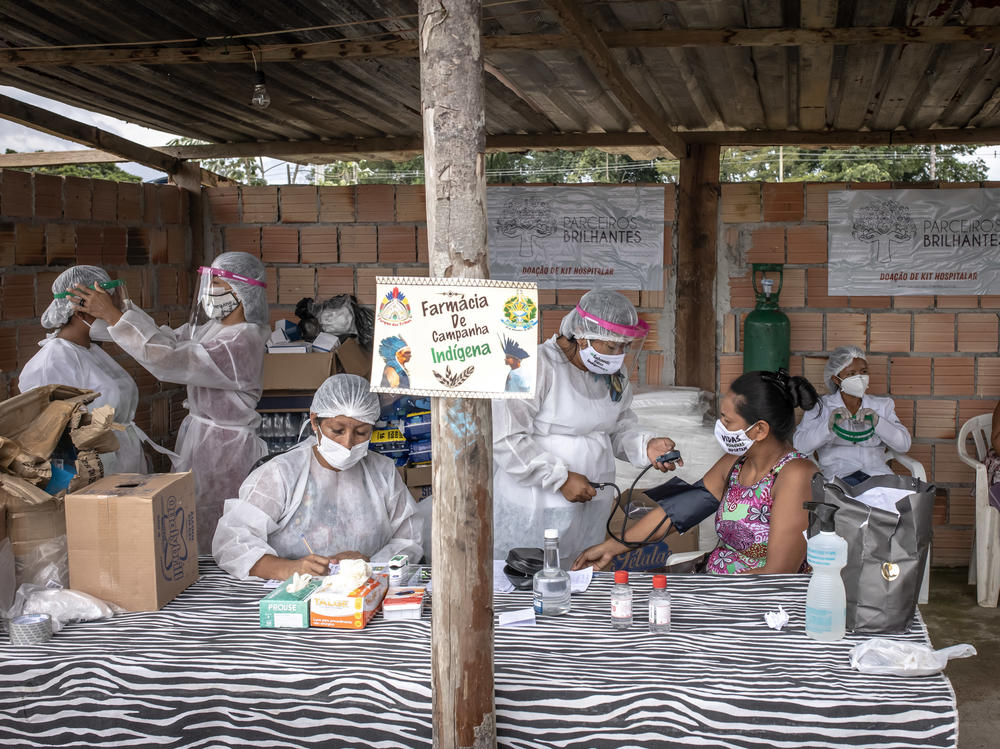Section Branding
Header Content
Why Scientists Are Very Worried About The Variant From Brazil
Primary Content
New coronavirus variants seem to be cropping up everywhere. There's one from the U.K., which is more contagious and already circulating in the United States. There's one from South Africa, which is forcing Moderna and Pfizer to reformulate their COVID-19 vaccines and create "booster" shots, just to make sure the vaccines maintain their efficacies.
But for some scientists, the most worrying variant might be the newest one. A variant called P.1, which emerged in early December in Manaus, Brazil, and by mid-January had already caused a massive resurgence in cases across the city of 2 million people.
On Monday, officials detected the first confirmed case of P.1 in the U.S., specifically in Minnesota. The state Department of Health picked up the case by randomly sequencing 50 nasal swabs from positive patients each week. The person infected with P.1. had previously traveled to Brazil.
"If you were to ask me right now, what's most concerning of all the things that I've heard so far, it's the fact that they are reporting a sudden increase in cases in Manaus, Brazil," virus expert Jeremy Luban at the University of Massachusetts told NPR two weeks ago before the variant arrived in the United States. "Manaus already had 75% of people infected [in the spring of last year]."
The concern with P.1 is twofold: Scientists don't understand why the variant has spread so explosively in Brazil, and the variant carries a particularly dangerous set of mutations.
While the variant from the U.K. took about three months to dominate the outbreak in England, P.1 took only about a month to dominate the outbreak in Manaus. In addition, Manaus had already been hit extremely hard by the virus in April. One study estimated that the population should have reached herd immunity and the virus shouldn't be able to spread easily in the community. So why would the city see an even bigger surge 10 months later? Could P.1 be evading the antibodies made against the previous version of the virus, making reinfections easier? Could it just be significantly more contagious? Could both be true?
"While we don't *know* exactly why this variant has been so apparently successful in Brazil, none of the explanations on the table are good," epidemiologist Bill Hanage at Harvard University wrote on Twitter.
Reinfections are a serious concern for several reasons. First off, like the variant from South Africa, P.1 carries a cluster of mutations along the surface of the virus where antibodies — especially the potent antibodies — like to bind. "They are kind of the major targets of the immune system," said virus expert Penny Moore at the National Institute for Communicable Diseases in South Africa and the University of KwaZulu-Natal. "So when we see a whole lot of mutations in [those surfaces], it raises the possibility that the mutations might be conferring immune escape." That is, the mutations are helping the virus evade antibodies or escape recognition by them. In essence, the mutations are providing the virus with a type of invisibility cloak.
To test out this hypothesis, Moore and her colleagues took blood serum from 44 people infected with the previous version of the virus and checked to see if the antibodies in that serum still worked against the new variant from South Africa. Or did the antibodies lose their sensitivity?
"Indeed that's what we saw," she said. "In fact, it was really quite a dramatic drop-off in sensitivity. We saw that in half of the serum, the antibodies were significantly less effective against the new variant [from South Africa]." So far, scientists haven't tested out P.1 in similar neutralization experiments, but P.1 has two mutations that scientists have already shown reduce antibody binding.
And thus, now we have a game of "cat and mouse," said virus expert Ravi Gupta, between the virus and the vaccine. The virus finds ways around the vaccine (and our immune system), said Gupta, and so the manufacturers have to reformulate the vaccines (or else we run the risk of getting infected twice).
"We've been here before with the flu. We're having to live with influenza and figure out a way of staying ahead of the virus by making vaccines on a yearly basis," said Gupta at the University of Cambridge.
"So I can imagine that we'll be doing something similar with [the] coronavirus. Eventually we'll need to design different vaccines that are targeting different parts of the virus — ones that the virus finds harder to change."
This process is going to cost the world a great deal of money — and take time, Gupta added. "I don't think there's going to be a single solution that just comes along in 2021 that says, 'That's it, we're done.'
"The coronavirus is going to cause a long-term disruption."
Copyright 2021 NPR. To see more, visit https://www.npr.org.

